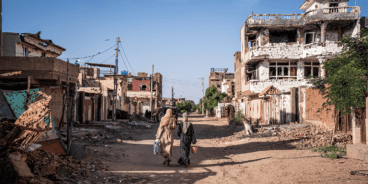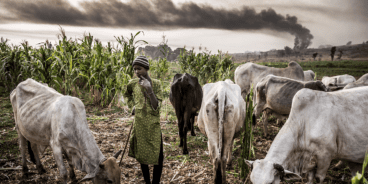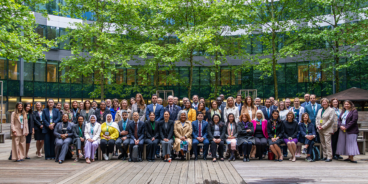
International Security, Human Rights and the Responsibility to Protect
Remarks delivered by Dr. Simon Adams in Moscow, Russia on 30 October 2013 at a conference on “State Sovereignty and the Concept of ‘Responsibility to Protect’: The Evolution of the International Situation and Russia’s Interests,” hosted by the Diplomatic Academy of the Ministry of Foreign Affairs of Russia.
I want to thank the Diplomatic Academy of the Russian Ministry of Foreign Affairs for the opportunity to participate in this historic event – the first conference on the Responsibility to Protect (R2P) to be hosted by your government. I want to digress slightly from my suggested topic and start, if I could, by addressing this vexed issue of sovereignty which has gripped our deliberations so far this morning.
Sovereignty has never been absolute and that is truer now than at any time since the Treaty of Westphalia. But that is not because R2P has undermined it. It is because the problems of the twenty-first century are quantitatively and qualitatively different from those of previous centuries.
Climate change, transnational terrorism, AIDS, mass atrocities, poverty and piracy – these issues are what former UN Secretary-General Kofi Annan described as “problems without passports.” They require fresh thinking and global partnership.
Mass atrocities, in particular, are a threat to all humans as humans. That’s why we define them – politically and legally – as crimes against humanity. That’s why we punish them as an affront not just to their victims, but to all of us as human beings. That’s why they constitute a threat to both international security and human rights.
The promotion of human rights is, of course, enshrined in Articles 1 and 55 of the UN Charter. And arguably, we wouldn’t have a United Nations at all if not for an international desire to avoid not just the scourge of war but also crimes against humanity. The UN was founded under the dark shadow of World War II and Auschwitz.
Some speakers here today have talked about what they don’t like about R2P. But how should we respond to mass atrocities in the world? Simply invoking sovereign equality or warning about “regime change” is not a sufficient practical response. And that is the whole point of R2P – to confront the reality of mass atrocity crimes in the world today in a way that is practical and principled. To respond to the reality of mass atrocities in a way that is legal and legitimate.
I had an opportunity to work in Rwanda years after the genocide and the recurring question I got from Rwandans was not whether genocide prevention was an obligation under existing international conventions, a legal norm or a political principle. The continual refrain was “where was the world?” Where was the world when one million Rwandans died in the fastest and most efficient genocide in history? Perhaps we’ve focussed a little too much on the legal and normative aspects this morning, because people are central to R2P.
R2P is not a conspiracy amongst Jennifer Welsh and myself – or by Gareth Evans or anyone else for that matter – to subvert national sovereignty. R2P is about answering that simple but most complicated question – what should the world do when faced with the most conscience shocking crimes? This is the context in which we should judge the merits and demerits of R2P.
Responsibility to Protect
First adopted during the UN World Summit in 2005, the largest meeting of heads of state and government ever assembled, the “Responsibility to Protect” commits all governments of the world to protecting their people from genocide, ethnic cleansing, war crimes and crimes against humanity. Although primarily a preventive doctrine, R2P also allows for coercive measures if a state is manifestly “unwilling or unable” to protect its people from mass atrocities.
R2P has played an important role in Côte d’Ivoire, South Sudan, Kenya and elsewhere. However, in the aftermath of the controversial 2011 NATO-led intervention in Libya, Brazil led a UN debate about how to protect civilians without lurching towards “regime change.” This is an important issue of international security and the Brazilian initiative was a critical clarification about what R2P is and is not.
Brazil’s argument that intervening powers also have a “responsibility while protecting” has not helped mobilize the divided Security Council with regard to Syria, but it has raised important questions about the methodology and motivations of civilian protection operations. Which is on reason why I believe Russia should join other states and support the Accountability, Coherence and Transparency (ACT) diplomatic initiative, led by Switzerland. Of particular importance is their recommendation that the permanent members of the Security Council should not use their veto in mass atrocity situations.
So how do we balance between security concerns and civilian protection needs? And what does this mean for international security and human rights?
R2P and Human Rights
Those dismayed by NATO’s “mission creep” while protecting civilians in Libya, or alternatively, by the bitter failure of the UN Security Council to do anything to stem the bloodletting in Syria, may well answer that R2P is endangered as a principle. I believe they are wrong.
R2P has been described by the former UN Special Adviser on the Responsibility to Protect, Dr Edward Luck, as the fastest developing international norm in history. At a meeting we both attended at the UK Houses of Parliament under the aegis of the all-parliamentary group for mass atrocity prevention, Dr Luck compared the trajectory of R2P since 2005 to the evolution of human rights norms after World War II.
Despite the Universal Declaration of Human Rights in 1948, the human rights situation in much of the world was still wretched during the 1950s. Cold War hypocrisies plagued the international system. Human rights terminology was worn thin by opportunistic misuse by all sides. It is only from the vantage point of a new century that we can look back and proclaim that despite this, human rights still made gradual, but cumulative, normative progress over the second half of the twentieth century. The underlying ideas were not fatally weakened by inconsistent application.
The enduring challenge was to work towards universal application. Acceptance of R2P is slowly but steadily increasing. Following the UN World Summit, the Responsibility to Protect was reaffirmed in Security Council Resolution 1674 (2006) and Resolution 1894 (2009). The Council also made reference to R2P in Resolution 1706 (2006) on Darfur. Although there have been divisive debates about R2P with regard to Sri Lanka and elsewhere, Libya and Syria have provided R2P with its biggest challenges. These cases are difficult precisely because they raise issues of accountability and coercion to halt mass atrocities – matters the UN Security Council has always struggled to address with consistent and proximate determination. Yet, despite rancour over Syria, the Security Council still invoked R2P more often in the year after Libya and the start of Syria crisis than it had done in the five years prior. In addition to R2P resolutions on Libya (Resolutions 1970 and 1973), between March 2011 and March 2012 the Security Council invoked R2P in resolutions on Côte d’Ivoire (resolution 1975), South Sudan (resolution 1996), and Yemen (resolution 2014). There were also two follow-up resolutions on Libya (resolutions 2016 and 2040). In addition, Resolution 2085 of 19 December 2012, which authorized an intervention force in Mali, also mandated the force to “support the Malian authorities in their primary responsibility to protect the population.”
Altogether, that’s eight R2P resolutions. Russia voted in support of seven of these and abstained on the eighth (1973). It voted for resolution 2085 which authorized the use of force by a major Western power (France) in a developing African country (Mali).
We should also remember the four Russian aircrew that were killed in Jonglei, South Sudan in December 2012 while supporting a peacekeeping mission that has an explicit R2P mandate. And we should keep in mind that 8 out of 16 current Security Council authorized peacekeeping missions in the world today have the protection of civilians at the core of their mandate.
The reality is that R2P has cautiously but inexorably moved from moral abstraction to being part of an ongoing debate about the practicalities of implementing measures to protect civilians who might otherwise be marked for death. It is for this reason that at the end of 2011 UN Secretary-General Ban Ki-moon argued that, “I would far prefer the growing pains of an idea whose time has come to sterile debates about principles that are never put into practice.”
The Future
Have the circumstances that gave rise to the adoption of the Responsibility to Protect at the 2005 UN World Summit ceased to exist? Are mass atrocity crimes a thing of the past? The answer from the perspective of those burying their dead in Syria, Sudan or the Democratic Republic of the Congo would be clear enough. While some situations have resisted resolution (Syria, Sudan, DR Congo) and others have clearly worsened (Burma/Myanmar, South Sudan, Nigeria), concerted domestic and international collaboration decreased the risk in other countries and therefore strengthened international security and human rights.
Attempts to portray R2P as, essentially, an ideology of military force overlook the fact that prevention is the heart and soul of R2P. To cite just one example, on 4 March 2013 Kenyans voted in the country’s first general elections since violence following the December 2007 presidential ballot left 1,133 people dead and over 663,000 displaced. Concerted diplomatic action led by former UN Secretary-General Kofi Annan not only ended atrocities and led to a power-sharing government, it was also lauded as the first example of “R2P in practice.”
International engagement since then, coupled with widespread constitutional and political reforms enacted by the Kenyan government, helped ensure Kenya did not suffer a bloody post-electoral redux in 2013. R2P is concerned with the prevention of mass atrocity crimes, not the outcome of elections. But in Kenya R2P offered an analytical lens to understand the nature of threat facing the country, while also providing a tool for mobilizing preventive action.
Kenya also reminds us that while both governments and civil society talk endlessly about the importance of prevention, it is the part of R2P that we understand the least. Partly to address this deficit, in 2010 the governments of Denmark and Ghana embarked upon the R2P Focal Points initiative. Since then the governments of Australia and Costa Rica have also joined the facilitating group.
Altogether, since September 2010 thirty-five countries, representing the global north and south, have appointed a national R2P Focal Point. These states are actively building a “community of commitment” that increases our international capacity to prevent mass atrocities. Such a network would have been politically inconceivable only a few years ago.
Apartheid, Sovereignty and Crimes Against Humanity
Finally, as a former member of the African National Congress of South Africa, I feel like I must also say a few brief words about the lessons from that conflict.
In the 1980s when I joined the international anti-apartheid movement, we did not accept the argument of the white South African regime that apartheid was purely a domestic matter, a matter of sovereignty, and that the world should look the other way while it got on with the business of marginalizing 85% of the population who were black, while also torturing political opponents and killing those it could not silence.
The UN agreed with us, not with South Africa. In 1973 the UN General Assembly described the apartheid system as a crime against humanity. The General Assembly focussed not only on South Africa, but any situation involving the systematic persecution of one racial group by another. As a result, “the crime of apartheid” is also one of 11 legally defined crimes against humanity under the Rome Statute of the International Criminal Court.
Apartheid in South Africa did not miraculously vanish. Apartheid was morally and politically defeated by its opponents. And it should also be acknowledged that this would not have been possible without crucial material support to the liberation movement from the Soviet Union.
But in assessing the circumstances that led to the death of Apartheid we have to acknowledge the crucial role played by global diplomacy, coercion (isolation and sanctions) and unrelenting international political pressure. Which leads me to pose some final questions.
What will those who come after President Bashar al-Assad say about the way the world responded when the Arab Spring turned cold and murderous in Syria? What will Egyptians say ten years from now about the mass killings of 14 August? How will Sudanese, Congolese and others talk about the UN and humanitarianism in a decade’s time? Did the world do all it could to help protect them in their darkest days?
Leo Tolstoy, the legendary Russian writer, once condemned government as “an association of men who do violence to the rest of us.” But fundamental to R2P is the notion that sovereignty entails responsibility and is not simply a license to kill. The Responsibility to Protect, like the UN’s Universal Declaration of Human Rights, is still only as strong as the determination of the international community to uphold its principles. That is precisely why the world needs Russia.
I know I don’t have to remind people here of the millions who lost their lives under totalitarian regimes during the twentieth century – including the 20 million who died during the Nazi invasion of the former Soviet Union. That invasion led to atrocities on an inconceivably vast scale. Russians suffered immeasurably. And of course, the Holocaust also began with the mobile killing squads of the Einsatzgruppe on the Eastern Front.
That history is why it is so important that Russia use its unique position on the UN Security Council to defend international security and human dignity and become an active supporter of R2P at the United Nations and beyond.
Related Content


Atrocity Alert No. 444: Nigeria, Haiti and South Sudan
